Top News
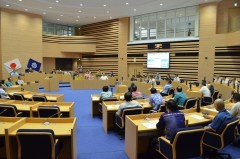
August 22, 2014 Ryukyu Shimpo
The U.S. and Japanese governments are building a new base in the Henoko district of Nago for replacement of U.S. Marine Corps Futenma Air Station. A majority of the Naha City Assembly members resolved to ask the governments to stop the construction immediately and give up the relocation plan. The assembly members of the Shimpu fraction of the Liberal Democratic Party (LDP), Komei Party and Japanese Communist Party, Social Democratic Party and Shakai Taishu Party and other opposition parties favored the resolution and filed a written opinion for it. Six independents and members of the LDP and Kaikakunokai opposed the resolution.
The written opinion states, “The Japanese government is forcing through building the base. They are ignoring the petition filed by the mayors of the municipalities in Okinawa requesting the easing of the base-hosting burden. They are also ignoring strong opposition against the plan from Nago Mayor Susumu Inamine and opinion polls showing that 73.6 percent of Okinawans oppose the plan. It went on to state, “The government’s act is against democracy and abhorrent to Okinawa.”
(English translation by T&CT)
Go to Japanese
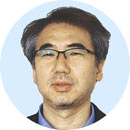
August 21, 2014 Ryukyu Shimpo
The Okinawa Peace Award is given to individuals and organizations that contribute to making peace and nonviolence in the Asia Pacific region. The Okinawa Prefectural Government announced on August 20 that Tokyo-based nonprofit organization Japan Heart became the seventh recipient of the award. Based on the idea of providing medical care to places where people have difficulties receiving it, the organization was founded as an international medical care volunteer organization in 2004. Japan Heart sent doctors and volunteers to Myanmar and Cambodia, which suffer from poverty and lack of doctors. They also offered medical services for free and taught doctors there.
In Japan, the organization has supported areas affected by the Great East Japan Earthquake, as well as providing doctors to isolated islands and secluded areas that severely lack medical providers. In Okinawa, the organization sent 12 clinical nurses to Kumejima Hospital from June 2008 to October 2010.
The board chairperson of the organization Hideto Yoshioka said, “I am thankful that our organization received the award from Okinawan people. We would like to further contribute to restoration of health for sick children in and outside Japan.”
A representative of the award selection committee said, “Japan Heart has built bonds between people in and outside Japan, which will last for a long time. Its dedication will contribute to creating a lasting peace.”
The award ceremony will be held at Bankoku Shinryokan Summit Hall on October 10.
(English translation by T&CT)
Go to Japanese

August 25, 2014 Ryukyu Shimpo
At 1:30 p.m. on August 22, the team of Nippon Television Network Corporation (NTV) successfully filmed the endangered Okinawan dugong underwater off the coast of Kayo in Nago. The NTV aired the film across the nation at 6:00 p.m. on August 24. According to the NTV, a member of the team spotted the dugong from their airplane and contacted colleagues riding in a boat. Staff cameraman Junpei Simizu approached the dugong under water and succeeded in filming it. On August 24, they captured a rare scene in which the dugong came swimming towards the camera.
The dugong appears to be a male adult witnessed often in the sea off the coast of Kayo. This animal has the split tail fin. The team of the NTV successfully filmed dugongs on May in 2007.
(English translation by T&CT)
Go to Japanese
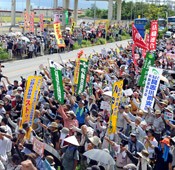
August 24, 2014 Ryukyu Shimpo
Citizen groups held a protest rally against the construction of a new offshore U.S. air base in Henoko, in front of Camp Schwab at 2:00 p.m. on August 23. The protest rally was titled, “Let’s go to Henoko to stop new base construction!” About 3,600 people, took part in the rally, the organizer announced. This became the largest gathering after July 1, when demolition of existing buildings within Schwab began towards the relocation for the U.S. Marine Air Station Futenma.
Participants raised their voices, “We will never allow the use of force by the government to push ahead with the work, ignoring the will of the people.” They passionately demonstrated to oppose the relocation of U.S. Marine Corps Air Station Futenma within Okinawa. The organizer is also considering holding a citizens’ rally of tens of thousands, calling for other groups to join. They plan to hold rallies like the one August 23 regularly in Henoko.
At the rally, Nago Mayor Susumu Inamine, representatives of civil peace groups, opposition lawmakers from Okinawa and members of the Okinawa Prefectural Assembly made speeches. A representative of the “All Okinawa United Forum”, which was set up by citizen groups, political and business people, announced the determination of opposing the base. The participants adopted a resolution to stop a new U.S. air base in order to protect the beautiful sea supporting so much life. They criticized the government for its heavy-handed way of doing things such as mobilizing state power like the coastguard. They determined that they would reject the building of a new air base and not allow the national authorities to reclaim the sea of Henoko.
At 9 a.m. on August 23, about 100 people gathered at front of the gate of Schwab. They marched to the Henoko Fishing Port. Shortly after noon, chartered buses, in which protesters were packed, arrived one after another from many regions of Okinawa. Many people could not ride in the chartered buses because they were overloaded, and some people could not get to the site for the rally.
(English translation by T&CT)
Go to Japanese

August 22, 2014 Tsuyoshi Arakaki of Ryukyu Shimpo
On August 20 and 21, the United Nations Committee on the Elimination of Racial Discrimination (CERD) investigated on racial discrimination in Japan. They also discussed policies on the U.S. military bases in Okinawa. One of the committee members pointed out that it is important to discuss with the local people and get their agreement on the planned construction of a new base in the Henoko district of Nago City for replacement of U.S. Marine Corps Futenma Air Station. Another said that local residents should be involved in the decision making. The committee will announce its final remarks and release an advisory report by the end of the month. One of the committee members stressed that the rights of Okinawan people to access traditional land and resources should be recognized and guaranteed. Another claimed that residents should be included in the decision-making process for policies that might affect their rights. They agreed that there should be local participation at the early stages of decision-making, especially regarding the U.S. military base issues.
Meanwhile at the opening of the meeting, a representative of the Japanese government said, “The residents of Okinawa and natives of Okinawa Prefecture are given and protected by legal equality with Japanese nationals under the Japanese Constitution.” The Japanese government presented their view that the economic gap between the mainland Japan and Okinawa has reduced, and that Okinawa has steadily developed in industry. They expressed respect for the prefecture’s initiative in implementing measures and policies since the Okinawan Promotion Planning policy, previously led by the state, was handed over to the prefecture.
To the Japanese government which does not recognize Okinawan people as “Indigenous People,” one of the committee members pointed out that it is important to consider how people in the Ryukyus identify and define themselves. Another pointed out UNESCO recognizes that Ryukyu/Okinawa has unique language, culture, and tradition and urges the Japanese government to recognize and protect such uniqueness. There have also been many inquiries about policies to protect Ryukyuan languages (Shimakutuba). A representative of the Japanese government asserted, “Those who live in Okinawa Prefecture or natives of Okinawa are not generally considered to be a group of people who share distinct biological or cultural characteristics. Therefore, they are not considered to be the subject of the International Convention on the Elimination of All Forms of Racial Discrimination.”
One of the committee members claimed the Ryukyu Kingdom’s long relationship with Ming and Qing Chinese dynasties, the history of annexation of the Ryukyu Kingdom in 1879 and assimilation policies promoted by the Japanese government all verify the indigeneity of Okinawans. He said it was wrong that Japan does not recognize this. Another said the Japanese government should respect Okinawan people’s will and guarantee their rights in light of this history.
(English translation by T&CT and Megumi Chibana)
Go to Japanese
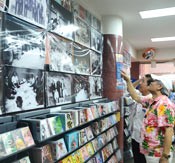
August 14, 2014 Ryukyu Shimpo
On August 12, the opening ceremony for music resource center Music Village was held at Ichibangai in Okinawa City. The Music Village exhibits photographs, sound sources, and films of Okinawa folk songs, jazz, rock, and other music.
The Music village is a part of a community development project using music sponsored by Okinawa City. The city aims to make use of music, art and culture as resources to develop the community. The city started to collect music sources in 2012, and more than 3000 photographs and sound sources are on display.
Sachio Kuwae, Okinawa City Mayor said, “We want to manage those important sources, inherit and develop the music culture.” Yoshikatsu Bise, the curator of the Music Village, said, “Finally, we opened the Music Village. But this is just the start.”
The Music Village opens from 11 a.m. to 7 p.m., and closes on Monday, public holiday, year-end and New Year holidays. For more information, please call Music Village 098 (923) 3224.
(English translation by T&CT, Hitomi Shinzato)
Go to Japanese

August 18, 2014 Ryukyu Shimpo
The 59th Okinawa Zento Eisa Festival was held at Koza Athletic Park in Okinawa City from August 15 to 17. Fifteen Eisa organizations from in and outside the city took part in the festival and attracted spectators to various performances. Many families and tourists visited the park from in and outside Okinawa. According to the event organizer, 310,000 visitors enjoyed the festival over the three-day period, which included a michijune parade.
To bring the festival to a close, the members of the Yamazato Youth Group of Okinawa City performed a lively Eisa dance that incorporated karate Kata. The spectators applauded, and cheered the performers.
(English translation by T&CT)
Go to Japanese
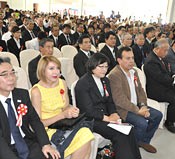
August 18, 2014 Ryukyu Shimpo
This year marks the 60th anniversary since Okinawans emigrated to Bolivia, and established their community by reclaiming dense forest. On August 17, a ceremony for the 60th anniversary of the immigration was held in Bolivia. The participants of the ceremony paid tribute to the first generation of Okinawan Bolivians. They urged the second and third generations to tell the history of their pioneers. The visiting group from Okinawa reflected on the difficulties the pioneers experienced. They pledged to keep connecting with the Okinawan Bolivian community in order to maintain the legacy of the settlement site and Okinawan identity in the country.
During the ceremonial period, an Okinawan college student Shun Kawamitsu who visited Bolivia for the occasion, interacted with all the Okinawan immigrants. Kawamitsu said, “I would like the settlement site to keep securing the identity of Okinawa. Even after coming back to Okinawa, I would like to continue to interact with Okinawan Bolivian people, and motivate each other.”
Naha Mayor Takeshi Onaga said, “Okinawan people and Okinawan immigrants share Chimugukuru or compassionate hearts. They are important for Okinawa to become internationally recognized. I hope that Okinawan people all around the world will get united to promote the prefecture.”
(English translation by T&CT)
Go to Japanese

August 15, 2014 Masaaki Umeda of the Ryukyu Shimpo
On August 13, an unveiling ceremony for a monument to commemorate the 100th year of Okinawan immigration was held in Campo Grande City, Brazil. The monument is 180 centimeters in width and 250 centimeters in height. The monument was built at a park in an area where Okinawans migrated for railroad construction work 100 years ago. About 60 people from a group visiting from Okinawa, including Vice Governor Kurayoshi Takara and Okinawan migrants from neighboring countries, took part in the unveiling ceremony. On August 14, a ceremony for the 100th anniversary of immigration will be held.
In 1908, an immigrant ship Kasadomaru arrived in Brazil and Okinawan migrant workers engaged in the construction work of a railroad from Sao Paulo to Campo Grande. From 1914, Okinawans began settling in Campo Grande.
At the ceremony, Vice Governor Takara made a speech, saying, “Thanks to 100 years of effort, Okinawans are now accepted in the Brazilian society. I would like to express thanks to our forerunners.” The president of the Campo Grande Okinawan Association Kiyoshi Nilton Shirado said, “If there was no contact with Japan, we would all become Brazilian-only within the next 100 years. We would like to stay in touch with Japan.”
(English translation by T&CT and Megumi Chibana)
Go to Japanese
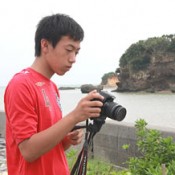
August 11, 2014 Ryukyu Shimpo
The U.S. and Japanese governments are preparing to build a new base to replace U.S. Marine Corps Air Station Futenma to Henoko in the Nago district. While the Japanese government was not carrying out the work on August 10, many citizens who oppose plans to build the base, visited from in and outside Okinawa to see sit-in protesters gathering in a tent at the base gate. One of the visitors was Soshi Nobu of the Okinawashogaku High School who filmed the protesters with his video camera.
Nobu was born in Hiroshima Prefecture. Influenced by his father, he became interested in the base issues in Okinawa and the peace movement, and joined a high school in Okinawa. Although Nobu opposes the U.S.miliary bases in Okinawa, he has mixed feelings about the issue because one of his dormitory friends has a parent working on one of the bases. Nobu said, “I feel that it is hard to express my opposition against the bases.” However, he went on to say, “This is one of the difficulties Okinawa faces.”
After acting as a guide for a peace tour, Nobu realized he wanted to tell others living in the main islands of Japan how Okinawan people feel about the bases. He and his friends set up a plan to upload movies about the base issues in Okinawa on a website and social media. They plan to ask for airline companies to screen what they filmed in the airplanes bound for Okinawa.
Nobu filmed the people protesting on the night of August 10, and interviewed those visiting the tent. He said, “Some of the people distance themselves from the protest movement because they do not know why the participants are protesting.” He continued, “Our role as young people is to show how the protesters feel. I think our projects will encourage more young people to take part in the protest movement.”
(English translation by T&CT)
Go to Japanese
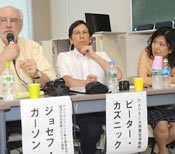
August 13, 2014 Ryukyu Shimpo
Ten years have passed since an American military helicopter crashed into Okinawa International University on August 13, 2004. On August 12, university students discussed the issues of the U.S. military bases in Okinawa at events held at the same university and other places in Ginowan.
Participants spoke candidly and exchanged opinions, pointing out the heavy burden of military bases as an “injustice.” One of them said, “I object to the building of the new base because I do not want to be dragged into a war or drag others into a war.” As ten years have passed since the incident, remembering the incident has become an important issue. Youth who had gone down to the construction site of the new military base being forced onto Henoko, Nago city were present at these events. They spoke with passion about facing the problems Okinawa has today.

Speakers at the symposium (from left) Motoki Tomoyose, Shion Manabe, Yoshino Taira, Jinshiro Motoyama, on August 12 at Okinawa Internationl University in Ginowan.
At the Okinawa International University, a symposium “Just Peace-Students Discuss ‘Ichimadin ikusayu’ (When Will War End?)” was held. Foreign intellectuals who have made statements against building a new military base at Henoko, Joseph Garson (American Service Friends Committee), Peter Kuznick (American University) and Satoko Noritmatsu (director of the Peace Philosophy Center) were invited to the symposium. Four students took the podium. About 130 people, mostly students, went to the symposium. Centered on military base issues, the symposium suggested ways for students to make their opinions heard and how to proactively learn about the reality on the ground.

Young people listened to speakers.
International Christian University third-year student Jinshiro Motoyama, 22, who was born in Nodake, Ginowan city, criticized the widely-opposed construction of a military base in Henoko on the basis that “peace” is when people solve conflicts through arriving at a mutual agreement.
“By expressing my views, I take action,” said Kansai Gaidai University third-year Yoshino Taira. She presented a parody of a television commercial she made to spread awareness and stir up interest among her peers about the Henoko military base problem.
Kyoto-born Meio University second-year Shion Manabe, who organized a screening of the film “The Targeted Village” at her university, said, “I think that it is unusual that only Okinawa has to bear the burden of a heavy concentration of military bases.”
University of the Ryukyus fourth-year Motoki Tomoyose, born in Okinawa City, stressed, “I do not want to become neither a victim of war nor an oppressor.”
Kuznick responded to a question from one of the students on whether or not America is a democracy. He said there was a time when it was, but now it is imperialist. Kuznick went on to say that Okinawa has been made to bear the burden of that change. Another audience member asked to Garson what peace is. He replied to the Okinawan saying, the belief that “life is a treasure” brings real peace. Norimatsu said, “I am touched by the profundity of the ideas shared by the students who took action.”
The symposium was organized by the Okinawa International University Peace Studies seminar and the cross-generation peace promotion group “New Wave To Hope.”
(English translation by T&CT and Lima Tokumori)
Go to Japanese













 Webcam(Kokusai Street)
Webcam(Kokusai Street)


